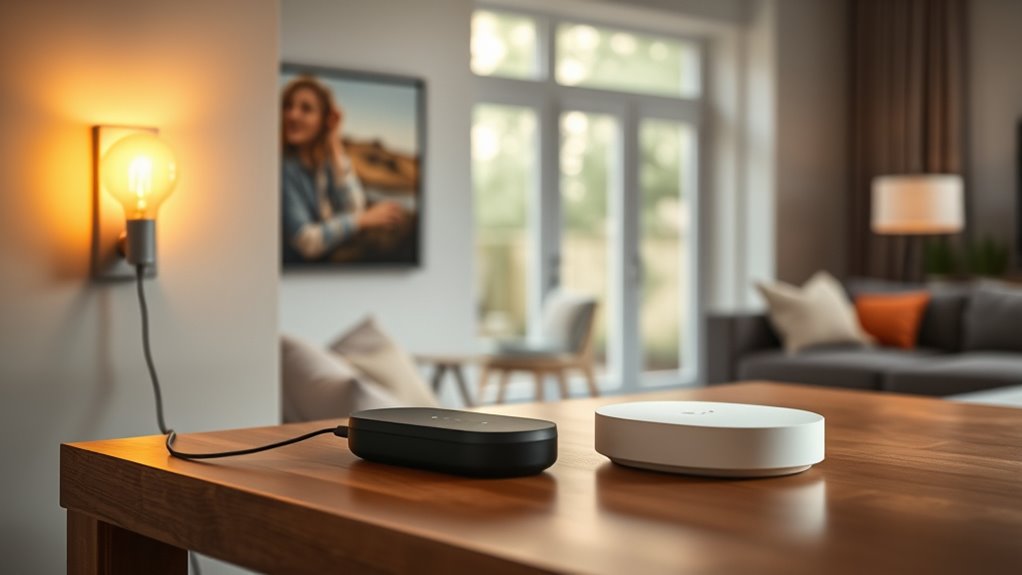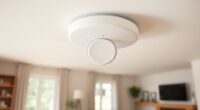To automate your home lighting with Matter and Thread devices, start by choosing compatible smart bulbs and switches that support these protocols. Set up a Thread-enabled border router to create a reliable mesh network, then add your devices securely through your preferred smart home app. Create automation scenes and schedules, control devices across different ecosystems, and guarantee everything stays updated for security. Keep exploring to discover how this setup can give you seamless, reliable lighting control.
Key Takeaways
- Ensure your home network includes a Matter-compatible border router supporting Thread 1.4 for device connectivity.
- Install Thread-enabled smart bulbs and switches using secure pairing methods via compatible apps.
- Configure automations through your preferred platform (Apple Home, Google Home, or SmartThings) for scheduling and scene control.
- Keep device firmware and system software up-to-date to maintain security, compatibility, and new automation features.
- Use multi-brand compatible devices to create seamless, cross-platform lighting automations and personalized scenes.
Understanding the Basics of Matter and Thread Protocols
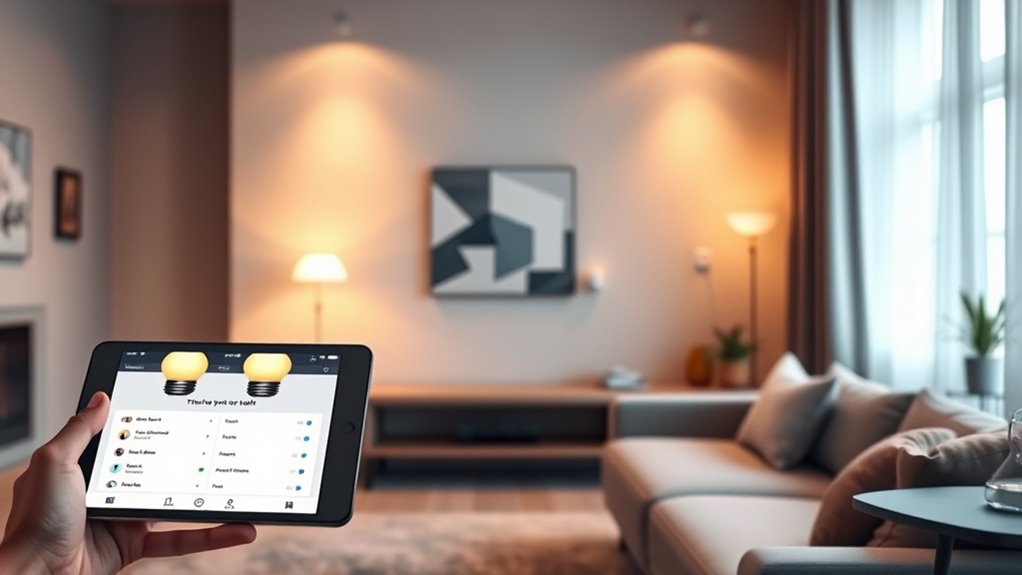
Have you ever wondered how your smart home devices communicate seamlessly across different brands? That’s where the Matter protocol comes in. It’s a unified communication standard that allows devices like lights, thermostats, and sensors to work together smoothly. Matter operates over IP-based networks such as Thread, Wi-Fi, and Ethernet, ensuring flexible connectivity. It uses a standardized set of commands and data models, so you don’t need to worry about compatibility issues. Built with security in mind, Matter includes end-to-end encryption to protect your smart home. The protocol was officially launched on October 4, 2022, with support from major industry players. By providing a common language, Matter simplifies device integration, making your smart home more reliable and easier to manage. Additionally, understanding AI security vulnerabilities can help ensure that your connected devices remain protected against potential cyber threats. Moreover, the use of Thread technology enhances the reliability and low latency of your smart home network, ensuring seamless device communication.
Choosing Compatible Smart Lighting Devices
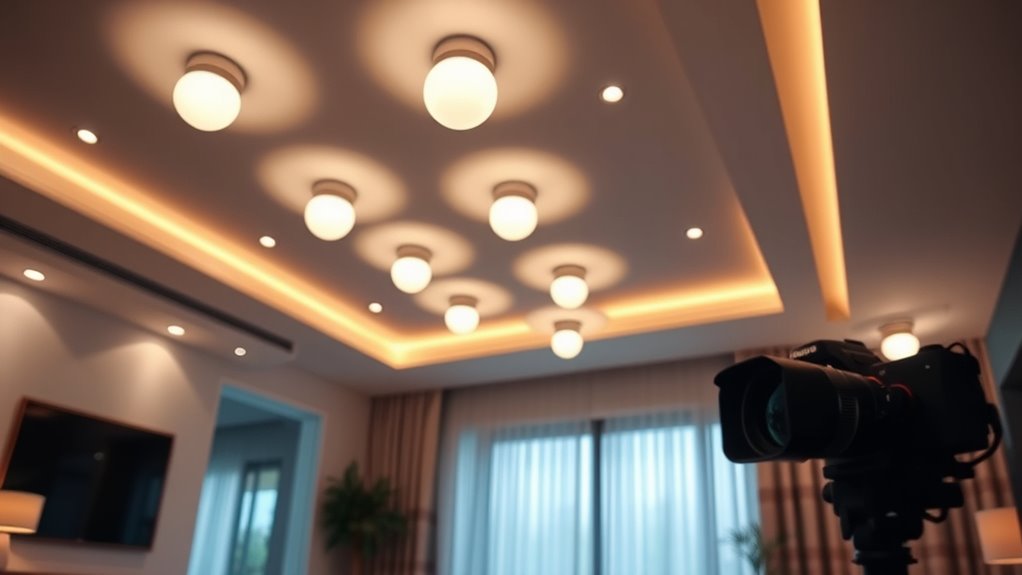
To choose compatible smart lighting devices, you need to verify their support for your smart home ecosystem and protocols like Matter or Thread. Check that firmware and hardware meet the requirements for seamless operation and future updates. Ensuring these factors align helps you avoid connectivity issues and guarantees smooth automation. Additionally, consider the Vetted – Mother Baby Kids standards to ensure safety and reliability in your device selection. Compatibility with wireless communication protocols ensures your devices can connect reliably over time and work harmoniously within your network, especially given their importance in maintaining consistent projector image quality. Incorporating an understanding of self-awareness can help you better assess your specific needs and preferences when selecting devices. Recognizing the significance of cultural variations in tableware can also inspire innovative aesthetic choices in your home lighting design.
Compatibility Verification Steps
Before purchasing smart lighting devices, verifying their compatibility with your existing home ecosystem and control platforms is vital. Start by checking if the devices support major Matter-compatible ecosystems like Apple HomeKit, Amazon Alexa, Google Home, or Samsung SmartThings. Confirm that the device works with the corresponding smartphone app for setup and management. Make certain the hub or controller supports Thread if needed, such as Apple HomePod Mini or Google Nest Hub 2nd Gen. Cross-verify if the device supports Matter and Thread protocols for seamless interoperability. Look for official Matter certification or manufacturer support for Matter and Thread. Use retailer filters or official device lists to verify compatibility. Additionally, consulting Video Tutorial resources can help you better understand the setup process and troubleshooting tips. Ensuring that your network infrastructure is robust and secure will further facilitate smooth operation and prevent connectivity issues, especially when integrating multiple smart devices. Incorporating security best practices can also safeguard your smart home from potential cyber threats and unauthorized access. Moreover, staying informed about interoperability standards can help future-proof your smart home system as new devices and protocols emerge.
Firmware & Hardware Requirements
Selecting compatible smart lighting devices requires ensuring their firmware and hardware meet specific standards. First, your devices need to support the Matter application firmware, optimized for lighting or switches, and enable Matter over Thread for reliable mesh networking. Second, hardware must include a Thread-enabled radio chip like the Silicon Labs EFR32MG24 and a 15.4 Radio Co-Processor (RCP) to interface with Thread networks. Third, devices should operate on the 2.4GHz band for mesh efficiency and support low-latency, energy-efficient LED drivers. Fourth, firmware must support interoperability with major platforms like Alexa, Google, and Siri, and receive regular updates to maintain security and compatibility. Additionally, compatibility with the latest mesh networking standards ensures future-proofing and seamless integration across devices. Incorporating standardized firmware and hardware components can significantly improve device interoperability and longevity. Ensuring these standards guarantees seamless integration, reliable operation, and future-proofing your smart lighting setup. Moreover, selecting devices with certified interoperability can help prevent compatibility issues down the line.
Setting Up Your Thread Network and Border Router
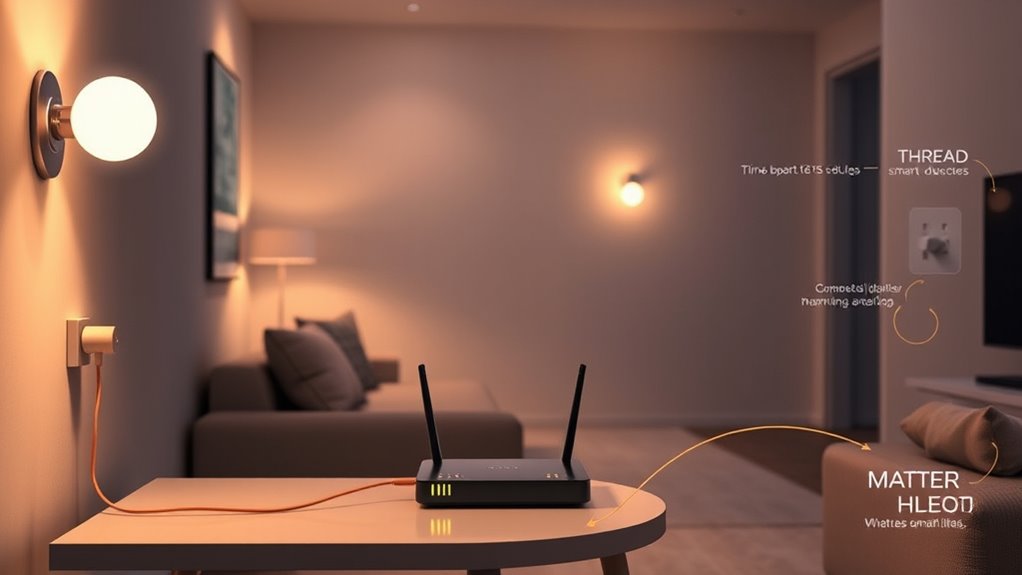
To set up your Thread network, you need to choose a suitable border router that connects your devices securely. Next, you’ll link your Thread-compatible lighting and sensors to this router, ensuring smooth communication. Additionally, it is crucial to configure your network properly to maintain security and reliable device operation. Incorporating cybersecurity best practices during setup can help prevent potential vulnerabilities in your smart home system. Ensuring your network adheres to security standards can further protect your devices from unauthorized access. Proper network configuration also involves selecting high-quality wall organization systems to optimize space and functionality within your home. Implementing sustainable practices in your setup can contribute to an environmentally friendly smart home environment.
Choosing a Border Router
Wondering how to set up your home’s Thread network? Choosing the right border router is key. Here’s what to contemplate:
- Compatibility: Ensure it supports Thread 1.4 and works with Matter devices.
- Hardware: Look for options like Raspberry Pi with a Thread Radio Co-Processor, such as Nordic’s nRF52840.
- Connectivity: Pick a router that connects easily to your existing Wi-Fi or Ethernet network.
- Redundancy: Opt for multiple border routers if possible, to maintain network stability and automatic mesh reconfiguration.
A good border router bridges your Thread network with your main home network, enabling seamless communication for your smart lighting and other Matter devices. Prioritize certified hardware for compatibility and future-proofing.
Connecting Thread Devices
Setting up your Thread network begins with connecting a compatible border router, which acts as the bridge between your Thread devices and your main home network. Once connected, the border router manages the mesh, allowing devices to communicate directly and relay messages for increased range and reliability. To add Thread devices, use companion apps like Apple Home, Home Assistant, or Google Home, and follow their commissioning process—scanning QR codes or entering codes. After pairing, devices appear in your network overview and can communicate even if the border router temporarily disconnects. You can use multiple border routers for better coverage and redundancy. Verify your devices are within range of the border router for successful connection, and monitor device status through your home platform’s interface. Additionally, understanding how mesh networking enhances connection stability can help optimize your setup. Furthermore, ensuring that your devices support Thread standards can improve compatibility and performance within your network. Proper network configuration also plays a crucial role in maintaining a robust and reliable Thread ecosystem, especially when considering interoperability between different device brands. Regularly updating device firmware can also help maintain security and functionality in your Thread network.
Ensuring Network Security
How can you guarantee your Thread network remains secure once it’s up and running? By implementing these best practices:
- Use strong, unique network-wide keys and refresh them regularly to prevent long-term compromise.
- Limit device joining permissions and ensure secure commissioning to authenticate new devices.
- Configure your Thread Border Router to filter ingress traffic, allowing only authorized connections into the network.
- Keep firewall rules strict, permitting necessary device communication while blocking unauthorized access.
- Regularly review and update firmware and security protocols to address emerging vulnerabilities and ensure ongoing protection. Additionally, ensure your border router supports secure network configurations and regularly update its firmware to patch vulnerabilities. Communications within the network are encrypted at the MAC layer, and devices obfuscate IP addresses for privacy. These measures, including network segmentation, keep your Thread mesh secure and resilient against threats.
Adding and Configuring Devices for Seamless Integration
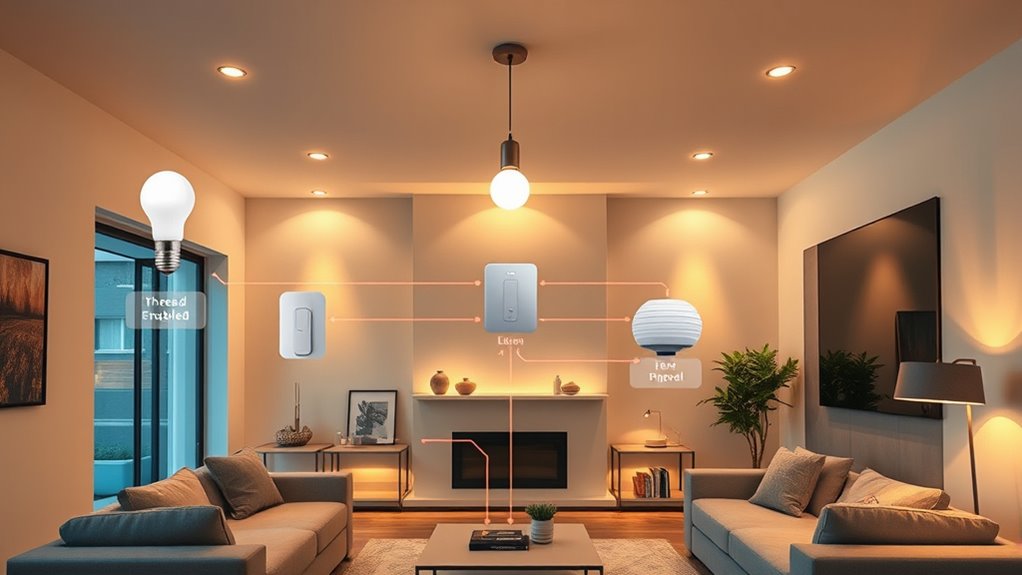
To guarantee your smart home lighting system works smoothly, start by confirming that your hub supports Thread and is Matter-certified, which guarantees compatibility across platforms like Apple Home, Google Nest, or Amazon Echo. Make sure your hub acts as a Thread border router, enabling device communication. Before adding new devices, verify they support Matter and Thread standards to avoid integration issues. Install Thread-enabled bulbs by screwing them in and powering them on, then use your smart home app to discover the devices. Scan the QR or pairing code on the packaging to securely add each device. Assign devices to specific rooms or zones for better organization. Keep firmware updated on all devices and your hub to maintain compatibility, security, and maximum mesh network performance.
Creating Automation Scenes and Schedules
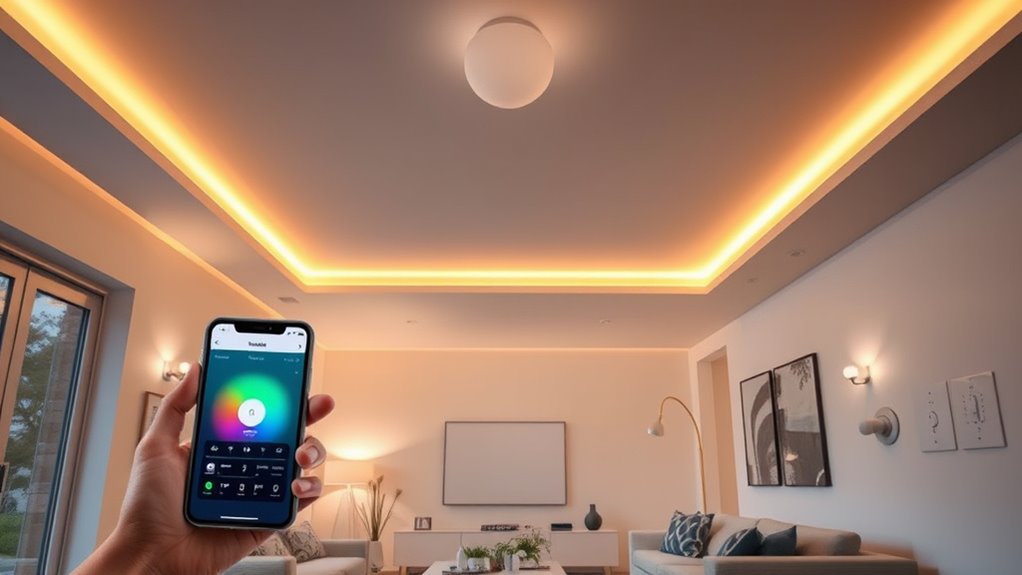
Creating automation scenes and schedules allows you to customize your smart home lighting to fit your lifestyle seamlessly. Scenes are preconfigured lighting setups you can trigger manually or automatically, adjusting brightness, color temperature, or turning multiple bulbs on or off for specific moods like reading or relaxing. Schedules enable you to automate these scenes or individual devices based on time or events, ensuring your lighting adapts effortlessly.
Here’s how to get started:
- Assign bulbs to rooms or zones for targeted control.
- Create scenes with specific lighting actions for different ambiances.
- Set schedules to activate scenes at designated times or dates.
- Use sensor triggers like motion or ambient light to automatically adjust lighting.
This combination makes your home lighting smarter, more efficient, and tailored to your daily routines.
Managing Device Interoperability Across Ecosystems
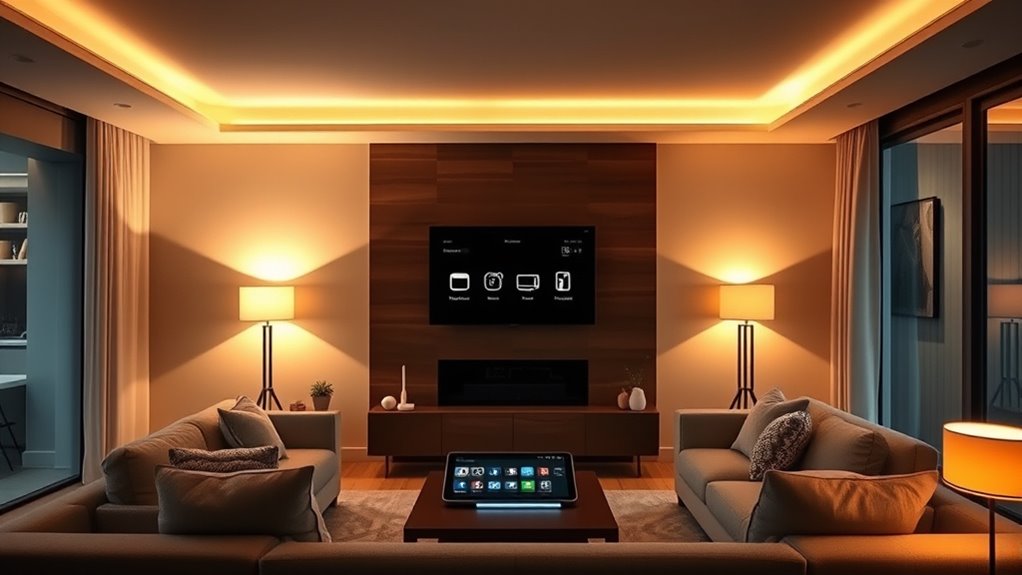
Managing device interoperability across ecosystems is essential for ensuring your smart home functions smoothly regardless of the brands or platforms involved. The Matter protocol acts as a universal standard, enabling devices from different manufacturers to communicate seamlessly using a common language. Supported by major companies like Apple, Google, Amazon, and Samsung, Matter simplifies setup and reduces delays, often cutting setup time by up to 40%. It uses local communication, so devices connect directly without relying on the internet, boosting reliability. Thread networking enhances this by creating a self-healing mesh network, ensuring robust, energy-efficient connectivity. To coordinate these devices, a central controller or hub manages onboarding, security, and platform-specific automations, allowing multiple ecosystems—like Apple, Google, or Amazon—to control your lighting devices simultaneously, ensuring true interoperability.
Ensuring Security and Privacy in Your Smart Lighting System
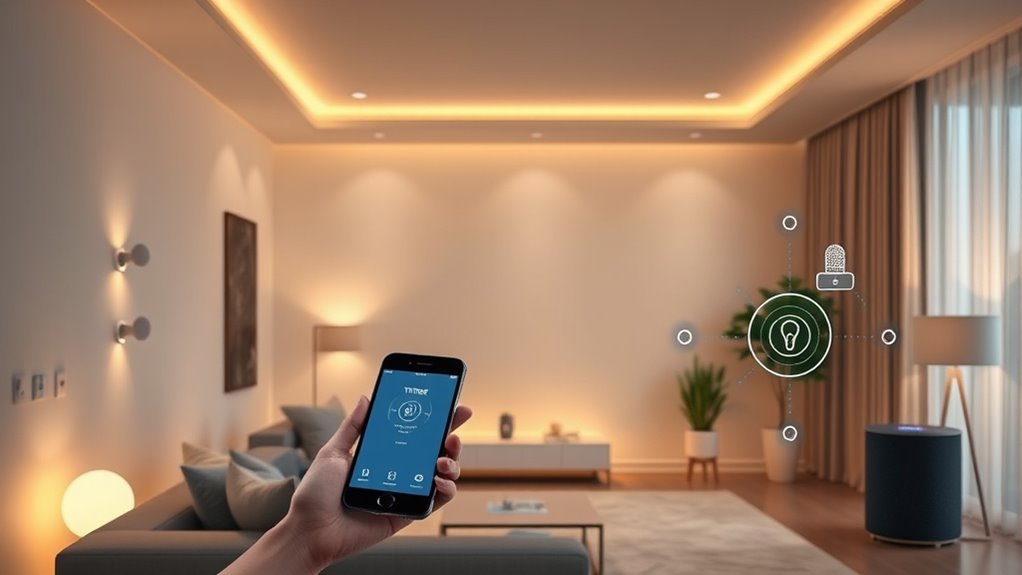
Ensuring security and privacy in your smart lighting system is crucial as these devices become more integrated into your daily life. To keep your system safe, consider these key practices:
Prioritize security and privacy to protect your smart lighting system as it becomes integral to daily life.
- Use AES-128 encryption to protect data transmissions, ensuring your commands and device data stay confidential.
- Follow secure onboarding processes that verify device authenticity, reducing vulnerabilities from unauthorized access.
- Take advantage of local control features, which operate without relying on internet connectivity, minimizing exposure to cloud-based threats.
- Manage access permissions through role-based controls and encrypted sharing, so only trusted users can modify settings or view device statuses.
Troubleshooting Common Connectivity and Performance Issues
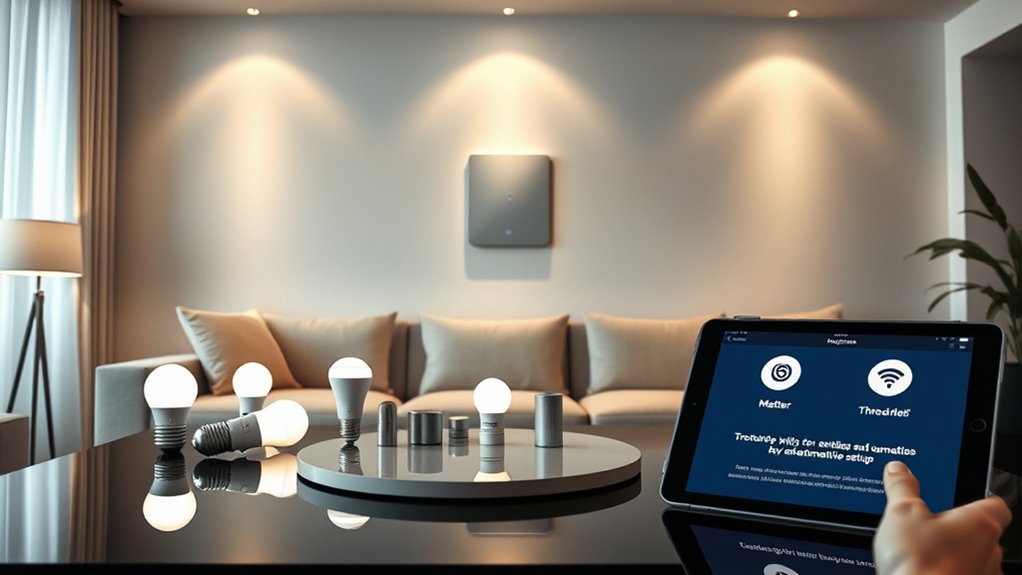
Connectivity and performance issues with your smart lighting system can be frustrating, but many are fixable with targeted troubleshooting. If your Thread devices like Nanoleaf bulbs drop offline or show as unavailable, even when powered, try power cycling or factory resetting them. Restarting Matter services or your hub may temporarily restore connection, but it often requires further steps. Proper placement of your border routers and hubs is vital; avoid thick walls and metal objects that can weaken the mesh network. Ensure your devices are evenly distributed and firmware is up to date. Firmware updates often fix known bugs, so keep your hubs and bulbs current. If problems persist, disabling conflicting cloud services or re-pairing devices can improve stability. Monitoring your network and device logs helps identify specific issues and solutions.
Exploring Future Features and Enhancements in Matter and Thread
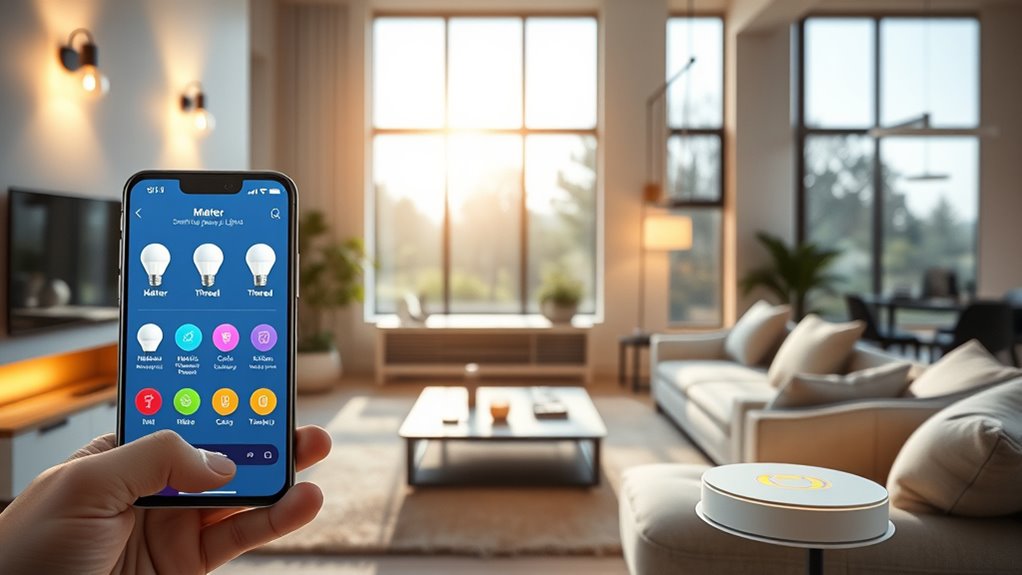
Advancements in Matter and Thread are set to transform how your smart lighting system operates in the future. You can expect better interoperability and easier device management, thanks to enhanced multi-admin support that allows seamless switching between platforms like Apple, Google, and Alexa. The adoption of Thread will boost your system’s reliability with a low-latency, energy-efficient mesh network that extends coverage. AI integration will personalize lighting by adjusting brightness, color, and even wellness features based on your habits. Additionally, the expanding ecosystem means more compatible devices with advanced features like scene creation and multi-brand control. Future firmware updates will be quicker and more streamlined, ensuring your lighting system stays innovative and adaptable.
Frequently Asked Questions
Can I Use Existing Zigbee or Z-Wave Smart Lights With Matter and Thread?
You can use your existing Zigbee or Z-Wave smart lights with Matter and Thread, but you’ll need a compatible hub or bridge, like the Philips Hue Bridge, acting as a translator. This setup allows your legacy devices to connect to the new protocol. Keep in mind, some features may be limited, and latency could increase. Upgrading to native Matter or Thread devices guarantees better performance and easier integration in the future.
What Is the Minimum Number of Thread Devices Needed for a Reliable Network?
You’re wondering about the minimum Thread devices needed for a reliable network. To guarantee stability, you need at least one Full Thread Device (FTD) acting as a router, which keeps the network organized and connected. For home lighting automation, 1–2 FTDs usually suffice, providing enough coverage and redundancy. Keep in mind, minimal networks rely on these FTDs, while Minimal Thread Devices (MTDs) depend on them for communication.
Will My Smart Lighting Features Work Fully Across All Ecosystems With Matter?
Your smart lighting features will mostly work across all ecosystems with Matter, but some advanced functions might not be fully supported initially. You can control and automate your lights seamlessly through platforms like Apple Home, Google Home, or Alexa. However, certain manufacturer-specific features could require updates or may not be compatible with every ecosystem right away. Overall, Matter guarantees broad interoperability, but check device specifics for complete feature support.
How Do Firmware Updates Impact Device Compatibility and New Features?
Imagine your smart home as a well-oiled robot—firmware updates are its magic oil. When you update, your devices gain compatibility and access to shiny new features, like cross-platform control. But beware: if updates are poorly tested, they could break things. By keeping your firmware current, you extend device life and enjoy smoother integration, all while ensuring your smart home stays secure and up-to-date without manual fuss.
What Are the Main Security Risks When Automating Home Lighting With Matter?
When automating your home lighting, security risks include misconfigured access controls that let devices communicate excessively or maliciously. If a device gets compromised, it can trigger unwanted actions across your system. Also, vulnerabilities in cryptographic keys can lead to impersonation attacks. Plus, unencrypted data or insecure network connections might expose your habits or allow hackers to hijack your lighting automation, increasing your overall security risk.
Conclusion
By understanding the protocols, choosing compatible devices, setting up your network, and creating automation scenes, you can effortlessly enhance your home’s lighting. Embrace seamless integration, prioritize security, and stay informed about future updates to keep your system reliable. With these steps, you’ll automate your lighting with confidence, enjoy smarter control, and experience a more comfortable, connected home—making every moment brighter, safer, easier, and more enjoyable.

